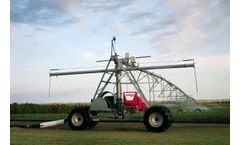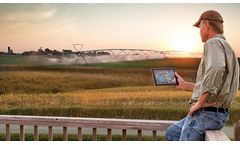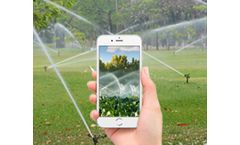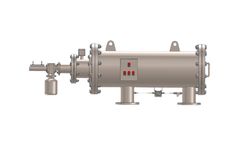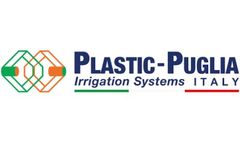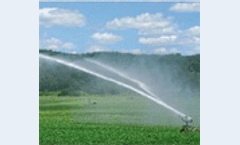Irrigation Management System Articles & Analysis
22 articles found
Key Difference between Lateral Move Irrigation and Centre Pivot Sprinklers, and What to Consider when Buying Lateral move irrigation systems, similar to center pivots, are a great solution for large fields. While center pivots rotate around a fixed point, laterals move continuously along the field’s length. This self-propelled design covers nearly 98% of the field area uniformly. The ...
Zimmatic Controllers – The Only Control Panel Compatible with Fieldnet Control panels have always been used on pivot sprinklers. New smart control panels, however, are revolutionizing pivot irrigation. These devices reduce water consumption and lead to savings in time and labour. Zimmatic control panels have everything for the grower who is ready to take complete control of their ...
To address this issue, intelligent irrigation systems have been developed to provide precise and efficient irrigation management based on real-time data. ...
ByJXCT
In the agricultural sector, automatic irrigation control systems have become a must-have device that can help farmers easily manage their fields, achieve efficient irrigation, and improve crop yield and quality. ...
ByJXCT
Using water contaminated with sediment, debris, or microorganisms can lead to clogged irrigation systems, reduced water flow, and the spread of diseases among plants. ...
At this point in the season, proper irrigation management can be a major contributor to the difference between a marginal and major improvement in crop yield and quality. ...
The ongoing ADHB-funded research project (currently in year two) is taking place at Neame Lea Nursery in Spalding, Lincolnshire, and uses deficit irrigation systems based on Delta-T Devices’s SM150T Soil Moisture Sensor, GP2 Data Logger, and DeltaLINK-Cloudremote access data service, to precisely control growing conditions. ...
Plastic-Puglia continues to invest in research and development of new products for irrigation. The company is moving into areas where the technology and water resources are scarce or mismanaged. ...
The most recent major drought, the “millennium drought” from 2005 to 2009, resulted in a 63% reduction in water deliveries to farms and devastated agricultural production. Managing this decades-old irrigation system has been a complex undertaking. ...
One of the main problems in water management of irrigation systems is the control of the equitable distribution of water among different orifice offtakes. The difficulty of managing a canal is partly caused by the lack of knowledge of the canal state because the scheduled demand is often not fulfilled, since farmers extract ...
The impact of potential future climate change scenarios on the irrigation water requirements (IRRs) of two major agricultural crops (coffee and seed corn) in Hawai'i was studied using the Irrigation Management System (IManSys) model. In addition to IRRs calculations, IManSys calculates runoff, deep percolation, canopy ...
Despite the plethora of irrigation scheduling decision support systems that have been developed over the past decades, there is little evidence of widespread adoption by farmers. This paper investigates the structural, institutional and political rigidities that affect the adoption of irrigation scheduling technologies in southern European ...
If two or more circles are running, the Watertronics system will turn on another pump automatically. I can pump 220 gallons (832 liters) to 6,600 gallons (24,984 liters) per minute off of the same system. ...
Improving Irrigation ROI Through Efficient Pumping Solutions Saving Energy, Water and Labor When fourth-generation Othello, Wash., farmer AJ Ochoa decided to upgrade his irrigation and water pumping system, he turned to a team of professionals from Lindsay and its subsidiary Watertronics, to help design and install one of the most efficient and ...
Skilled management of irrigation should start from planning at the regional level (Lorite et al., 2007). ...
Crop evapotranspiration is the most important parameter for management of irrigation systems in greenhouses. This study was conducted to determine the evapotranspiration of cucumber, tomato and peppers, using micro–lysimeter during seven months in a greenhouse located in central region of Iran. ...
This paper explores the long-term development of irrigation system management, and looks at the influence of legislation, irrigation system size, scalar stress and polarized land tenure in the existence and success of self-management. ...
Flawed incentivesWater use in agriculture is evidently becoming unsustainable in some parts of Europe, suggesting that regulatory and pricing mechanisms have failed to manage demand effectively. Farmers shift to water-intensive irrigation methods because of the productivity gains on offer. ...
Sydney's water consumption is at critical levels. Severe drought and population increases have placed pressures on existing water sources resulting in restrictions that affect the community. Whilst there is significant environmental, social and economic value associated with public open space, maintenance of these areas have been severely affected by water restrictions, and in some cases, local ...
Irrigation Communities, a common reference point for Water Users' Associations, are corporate groups that manage irrigation systems under local or indigenous charters. This paper begins by pointing out that local control in irrigation does not necessarily imply effective participatory management. ...

